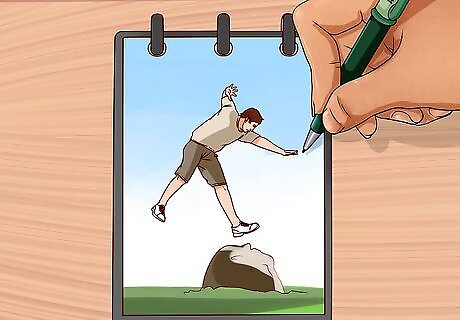
views
Returning to Sleep Right Away

Don’t move. If you wake up in the middle of a dream you wish to revisit, lie perfectly still. When you move around upon waking up, the sensory stimuli of your surroundings begins to interfere with the remnants of the dream lingering in your mind. This will quickly cause the remembered elements of the dream to dissipate.

Keep your eyes closed. It is much easier to return to sleep if you keep your body in a sleep-ready state. This means you should remain still, your body should be relaxed and, most importantly, your eyes should be shut. Light has the effect of waking up the brain, which is the last thing you want: if you’re to have any chance of recreating a dream environment, it has to be done fast, before the impression left by the dream fades. Keeping your room as dark as possible while sleeping can minimize unwanted light stimulation.

Breathe slowly and deeply. Keep your breathing under control. Try to take the same long, slow breaths you would when stretching after a workout. The sooner you can return your breathing to the cadence of rest, the better chance you have of falling back to sleep while the components of the dream are still buzzing in your unconscious mind. Regulated breathing techniques, like the 4-7-8 breathing method, might help you nod off faster if it tends to take you a while to get back to sleep. To perform 4-7-8 breathing, all you have to do is inhale slowly to the count of 4, hold your breath for 7 seconds and then exhale forcefully and completely to the count of 8. As the brain is oxygenated, the body will naturally enter a relaxed state and become more receptive to the hormones that induce sleep. Many people claim that by regulating their breathing, they are able to fall asleep in as little as one minute.

Recall the last impressions of the dream. Try to remember as much as you can about the dream you were having when you were jolted awake. What was happening? Who were the players involved? What did the environment look like? How did you feel about what was going on? Let yourself lie in that unthinking, emotionally receptive state until you manage to get back to sleep. Dreams are essentially random combinations of sensory reactions, feelings and thoughts that are mined from waking life. If you remain focused on resuming an aborted dream while falling asleep, there’s a greater likelihood that your next string of dreams will contain the same images and events. Many sleep researchers believe that the emotional response is the most influential factor in how much we remember of dreams.
Keeping a Dream Notebook

Remember all you can. If you’ve been thrust back into consciousness and there’s no chance of immediately returning to sleep, gather the dream in your thoughts. Take inventory of the most important and memorable details of the dream, and especially our place within it: what you were doing, how you were perceiving the action, etc. It’s important to try to grasp as much of the dream as you can while it’s present in your short-term memory. The part of the brain that forms and stores memories is effectively dormant when dreaming, so the details will quickly evaporate, possibly for good. If you’re unsure whether you actually remember a certain detail or your imagination is just filling it in, zero in on it anyway. If nothing else, it will come in handy for helping you resume a dream that’s close to the original, with missing details supplied by your own creative touch.

Solidify the ideas of the dream. Turn each remembered impression into a real thing with physical qualities. Focus on how things looked and sounded, what the setting was like and any other sensory aspects you can recollect. This will give your mind images of substance to fix on while you attempt to redirect it back to the dream state. A good method for coaxing out as much detailed memory as possible is to quiz your dream memory on the six basic questions that journalists attempt to answer when investigating a story: who, what, where, when, why and how.

Write out the details of the dream. In as much detail as possible, write out what happened in the dream from the viewpoint from which it occurred. If you’re able to remember an entire scene, put it down from beginning to end. If you only retain fragments of the dream, try to order them with as much continuity as you can so that your brain can get back in the groove. Record the content of the dream accurately: it’s important that your mind be able to recall all the relevant details, like giving a description of a suspect to a police sketch artist. Don’t wait to jot down what you remember from a dream. It’s easy to fool yourself into thinking that you’ll be able to recall the dream later, but it’s never as simple as you think it will be. Don't worry about spelling, grammar, or even writing in straight lines when scribbling an entry in your dream notebook. Just make sure you get it all out while it's on your mind!

Create sketches of the action. On a blank page next to your description, make a few quick drawings of the action that transpired in the dream. Give characters and happenings more of a visual foothold in your memory, as well as something to hold in your mind when you try to return to the dream. Think about the storybooks you read as a kid, and how they provided illustration for the major events of the narrative. Your dream notebook should contain as much as you can remember about each phase of the dream. If you wish, you can go so far as to color your dream sketches, or create a kind of progression of drawings like the storyboard for a film. The more detail you can record, the better.
Guiding Dreams Through Meditation

Prepare to go to sleep. In some instances, you may be trying to continue or revisit a dream that you had several nights or even weeks before. Start by getting your body ready for slumber, with eyes closed, body totally relaxed and breathing under control. Let your breath begin a natural rhythm. Shut out all thoughts unrelated to the dream you’re attempting to access. Make sure there are no unnecessary distractions in the room around you, like a television or radio that might make falling asleep difficult or wake you unexpectedly. If you’ve been keeping a dream notebook, it can be helpful to review it prior to falling asleep so that the images remain firmly planted in your thoughts.

Conjure the experience of the dream. Run your mind over the textures of the remembered dream, all of its sensory elements and the way it made you feel when you first experienced it. Put yourself back in that original emotional state. As you pass into sleep, think of your consciousness as in transit with the desired dream as your destination.

Play through the dream repeatedly. Imagine that the dream you wish to relive is a scene from a movie being projected in your mind over and over again on repeat. Work through each individual section painstakingly, immersing yourself not only in the atmosphere of the dream but in the familiarity of the cycle. The most clearly remembered details from dreams are usually taken from the end of REM sleep, right before you wake up. If you’re trying to carry on a particular dream, try to time the cycling of the remembered dream so that you fall asleep with the most vivid details fresh in your thoughts. Combine your dream visualization with calming regulated breathing techniques, and play through the most memorable parts of the dream slowly in your mind, like a film being played back at half speed.

Try to fall asleep with the dream on your mind. With any luck, you’ll pass successfully into sleep during the process of recollecting the details of your dream and consequently find yourself in a kind of variant of the original dream, complete with the same basic features but differing in the way that it plays out. With practice, you’ll gain further control over the structure of your dreams, revisiting the same type of dream multiple times, changing the action and outcome of your dreams and even choosing what to dream about. If revisiting a certain dream doesn’t work on the first try, don’t get discouraged. It may take many attempts before you’re able to recreate a dream. The practice of training oneself to moderate one’s dreams is known as “lucid dreaming”, thought by many to be a little-known way of exploiting the unconscious processes of the mind that take over when we’re asleep.



















Comments
0 comment